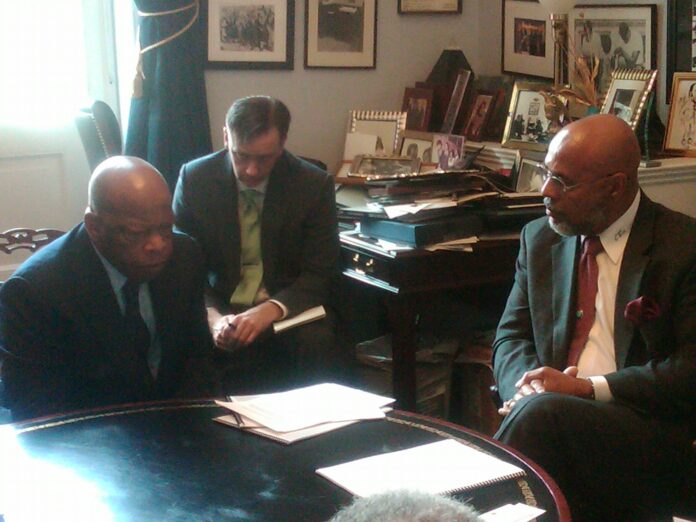![]()
![]()
![]()
![]()
![]()
![]() In the photo: The late Congressman John Lewis and Charles Blatcher, III, chairman, National Coalition of Black Veteran Organization.
In the photo: The late Congressman John Lewis and Charles Blatcher, III, chairman, National Coalition of Black Veteran Organization.
By: Charles Blatcher, III
Chairman, National Coalition of Black Veteran Organizations
April 22, 2025
With the Trump Administration’s recent focus of attention on the National Museum of African American History and Culture, I have read few misguided opinions about how the institution came about. The actual creation of the museum transcends the legislation submitted by the late Congressman John Lewis in 1986 calling for its construction. The legislation marked the resurgence of an idea proposed by Black Veterans returning home from World War I. The idea was abruptly curtailed by the Great Depression of the 1920’s. The idea laid dormant until the late 1960’s when Reverend Doctor Martin Luther King, Jr., reintroduced the idea. The idea died with his assassination in April 1968.
The idea for a national museum reemerged in 1976 in a modified form calling for a facility dedicated to Black/Minority Military History. The idea was proposed and chartered in 1978 by Black veterans in Oakland, California under the aegis of the National Minority Military Museum Foundation. As the co-founder of the organization, I can attest that the call went forward with no prior knowledge of the past advocacies. The motivation was strictly to establish a home for a segment of American History ignored in public education and history books. There was no permanent national home for the subject in the nation.
The Foundation reached out to veteran organizations nationwide to encourage in a unity of purpose in advocating for a national home for history. The outcome, approximately two dozen organizations joined forming the National Coalition of Black Veteran Organizations. Based on the importance of history, we had no illusion that we could establish a national museum beyond the authority of the nation. For example, England has the Imperial War Museum and France has the National Museum of the Armies both represent their militaries in their entirety. Our assumption did not stop others from coming forward with their own version of national military museums. The Tuskegee Airmen decided they would create a national airmen’s museum in Detroit, a National Afro American Museum was established in Wilberforce, Ohio, and the Buffalo Soldiers National Museum was established in Houston, Texas. The branches of the Armed Forces established what they called national facilities, e.g., The Infantry Museum at Fort Benning and The Warrior Museum at Fort Hood. The Army constructed the National Army Museum at Fort Belvoir, Virginia. The Air Force followed suit creating the National Air Force Museum at Wright-Patterson Air Force Base in Ohio. The Marine Corps established a National Museum in Triangle, Virginia, and the Navy followed suit with a National Aviator Museum in Pensacola, Florida. They all missed the point of what we were proposing. Our interpretation was an entity representing all branches of the services located in the nation’s capital under the auspices of the Smithsonian Institute. One could certainly argue the more appropriate location for a National Military Museum would be on the property or adjacent to Arlington National Cemetery. Our advocacy continued up until the announcement that legislation had been signed to establish the National Museum of African American History and Culture. Our persistence was due to our belief that Washington, DC was the most fitting location. The nation’s capital attracts more tourism than all the other locations combined offering greater visibility to a global audience.
We credit our advocacy with success in the establishment of the NMAAHC. Black Military History has a gallery in the institution permanently dedicated to the subject. Without a doubt our advocacy between 1978 and 2003 influenced the signing of the legislation. The unsolicited invitation of the coalition to serve on the preliminary planning team for the institution lends credence to that claim. Despite our dissatisfaction with the gallery’s space limitations, we succeeded in institutionalizing Black Military History in a national facility.
Let it be known, we will continue advocating for proper American history recognition within the context of the facility, beyond the Donald J. Trump and Lonnie Bunch Administrations. Afterall, it was Black Veterans who initiated the idea for the national museum, and Black Veterans who revitalized and advanced the concept to its fruition, a fact that should not be overlooked. The advocacy will persist until Black Military History receives proper recognition within the context of the institution of the United States. We are adamant Brigadier General Charles Young is deserving of a statue on the grounds adjacent to the NAAMHC. In addition, Black Military History is more deserving of major gallery space in the national facility than a replica of Oprah Winfrey’s studio. Without doubt, the servicemen and servicewomen had a greater impact on the passage of Civil Rights than any television talk show.
####### contact information cnmmmf@aol.com #######







